
How To Handle Outdated Content, Earn More Traffic, & Grow Ad Earnings

Get helpful updates in your inbox
How To Handle Outdated Content, Earn More Traffic, & Grow Ad Earnings
Publishers already know that working on SEO, writing really great content, and staying on top of publishing trends is important to their website’s success. However, what some seasoned publishers may not know is that they actually have a secret weapon: a mature website with mature content.
Unfortunately, this isn’t often seen as the asset that it is. It can often be seen as outdated content that may need to be removed…
If you have a mature website, you’re likely working hard to stay at the top of the rankings and remain profitable by updating your site, obsessing over site speed and keywords, and quickly churning out new content.
Meanwhile, you may be ignoring one of your greatest assets. In fact, you may be considering how to remove outdated content under the guise of “content pruning”.
WAIT!!!!
Don’t remove outdated content or try “content pruning” until reading this…
In a perfect bubble, if a new domain with great content pushes out a new article and a more well-established publisher publishes out the exact same quality of content, they’re likely to rank higher. Sites with established domain age and authority are more likely to have top-ranked articles than domains that are more recently established.
But what if your mature content is thin, outdated, and not very attractive? Delete it, right?
No! That outdated content is an asset. Even if the content itself has little value or traffic today, the URL and age of the page may offer a weapon you can use to gain more traffic quickly.
Recently at Pubtelligence — an event hosted at Google offices in New York — Anita Campbell from SmallBizTrends.com shared how their publishing business turned outdated, mature content into a powerful asset to grow organic traffic and total ad earnings.
The full video is below, but you can read our synopsis underneath.
What if I told you that if you have a site that is even a few years old, you may be sitting on a gold mine, and it’s all within the content you’ve already produced? – Anita Campball, Founder of SmallBizTrends
Smallbiztrends.com was very familiar with the previous scenario about a year ago. They had plenty of traffic and were producing a large amount of new, quality content, yet their revenue wasn’t keeping up. Anita Campbell, CEO and founder of Small Business Trends, began asking data-driven questions and started looking for a solution.
Anita then shared how her 15-year-old site has stayed on top by producing less new content while becoming more profitable and improving the user experience.

No SEO experience, an aging site, and some outdated content
Many independent publishers will find that Anita’s publishing story is not much different than their own: she started with little to no SEO or media experience (she actually has a background in law) but was passionate about a subject and could write great content.
In 2003, Anita launched a small business newsletter. That newsletter eventually transitioned into Small Business Trends, a website with more than millions of unique visitors per month.

Small Business Trends has been profitable almost from the beginning, with no outside investment or debt. The success of the website comes down to the fact that Anita, and those she has hired, are really good at making quality, profitable content.
Since 2004, smallbiztrends.com had used Google AdSense and was working with advertisers directly to accrue revenue. However, the volume of traffic and the amount of revenue coming in were not correlating appropriately, so she and her associates began to question: what are we missing?
In 2018, Small Business Trends underwent a massive content updating process and also started using Ezoic’s machine learning to better monetize their ad inventory. Within a year, Small Business Trend’s EPMV (earnings per thousand visitors) increased by 600%.
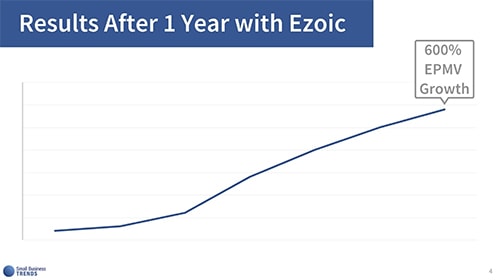
The 80/20 rule applies to your website content
In addition to an increase in ad revenue, Anita and her team found value in the content tools and analytics on the Ezoic platform to better understand the performance and shortcomings of their content.
What they learned from this data was that Small Business Trends was earning 80% of their revenue from about 20% of the pages on their site, meaning 80% of the content on their website wasn’t very profitable. Additionally, Anita and her team saw that not only were they making the majority of their revenue from a small number of pages but that the most profitable content was also their more seasoned content. So they asked themselves
“If we’re earning X amount from 20% our current pages, what would happen if we were able to earn 40% from our existing content?”
With this in mind, they dove back into their archives to analyze which pages they could clean up and give better visibility.
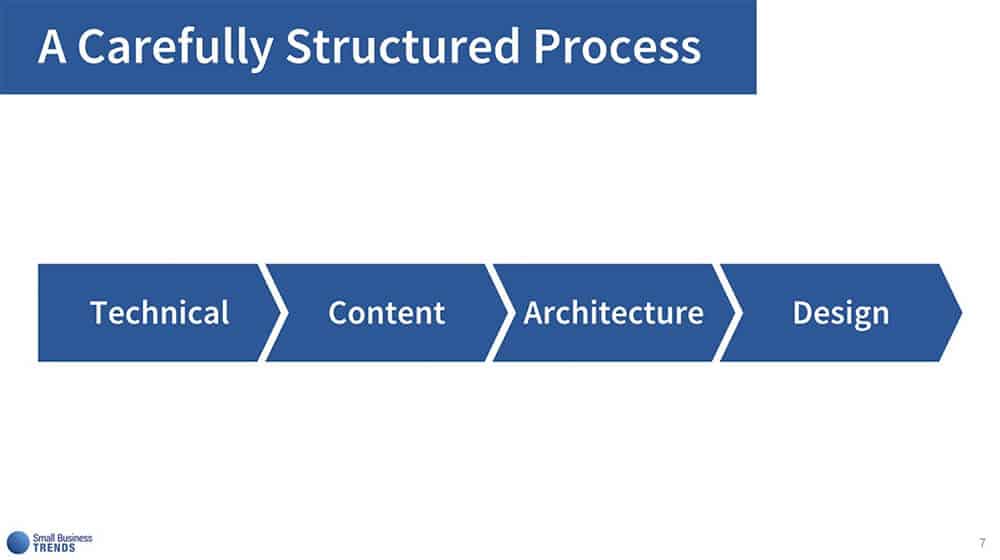
CTO of Small Business Trends, Leland McFarland, set up an SEO audit using SEMRush to audit and crawl the website. Based on the information they gathered, they set up the following priorities: technical, content, architecture, and design.
They structured many of the principles of their outdated content strategy around information Ezoic’s own Tyler Bishop had shared at a previous Pubtelligence.
How to technically fix old content
Small Business Trends began with technical fixes: if search engines can’t crawl a website’s pages and users can’t access those pages, it will naturally impact revenue and traffic. Technical fixes also have more concrete steps and results than other parts of operating a digital publication.
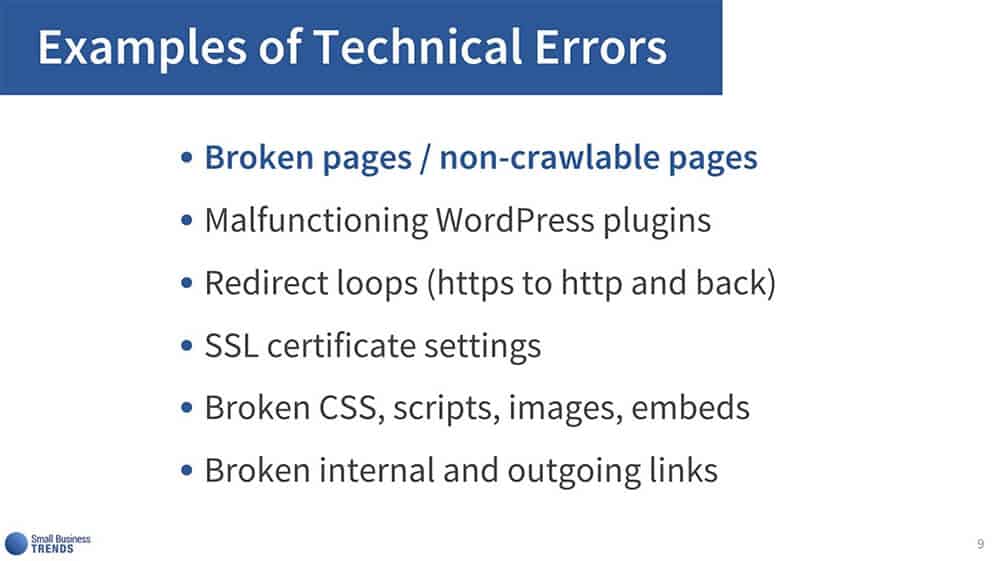
As Leland discovered, Small Business Trends had many broken pages and links.
The first time the site was crawled, it pulled about 600,000 issues of varying severity: almost 10,000 errors and over 11,000 broken links were flagged. The flags were then split up into manageable pieces and organized into a schedule that their team updated weekly.
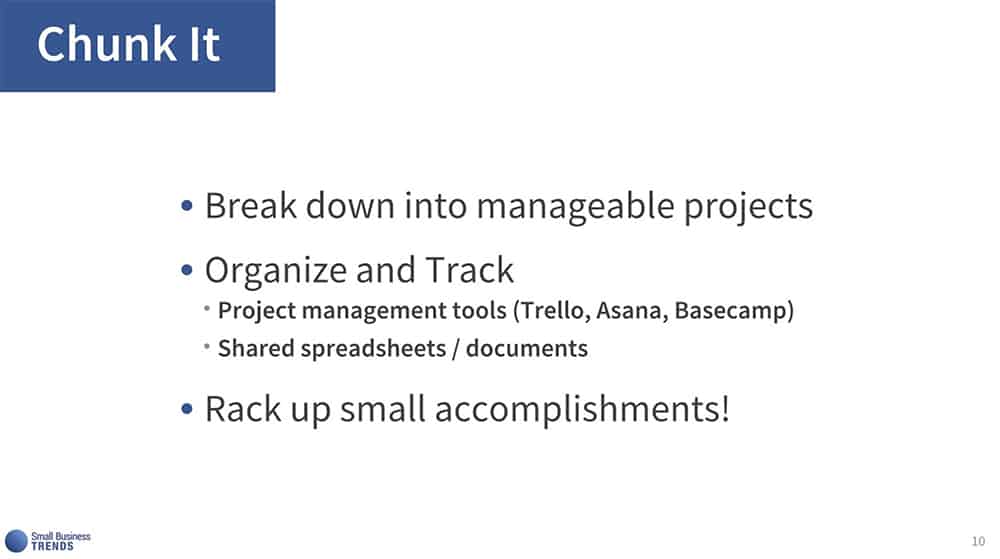
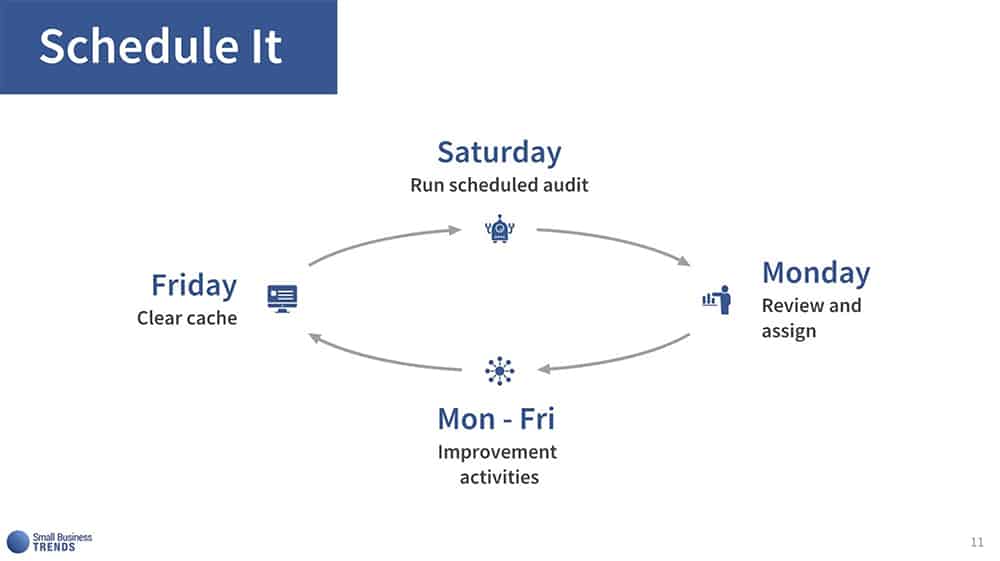
Small Business Trends usually publishes about 50 articles per week but during their tech clean up, that was scaled back to around 36 articles per week. The publication also had to turn down some labor-intensive deals, which would have potentially brought in immediate revenue.
By investing in their existing content more, they chose to invest more time into content that would generate reoccurring ad earnings rather than short-term direct deals or sponsored content.
When smallbiztrends.com reduced the number of articles they published per week and focused on repairing broken elements of the site, the website had an immediate increase in organic traffic (primarily Google search).
Building a content strategy and getting everyone on board
Everyone on the Small Business Trends team helped work on broken items and were provided with some educational courses on SEO and site structure to help assist with the cleanups.
Small Business Trends also implemented the Broken Link Checker WordPress plugin to help change broken links easily. Anita incentivized the lengthy process and additional work on the team through different games and audit score improvements.
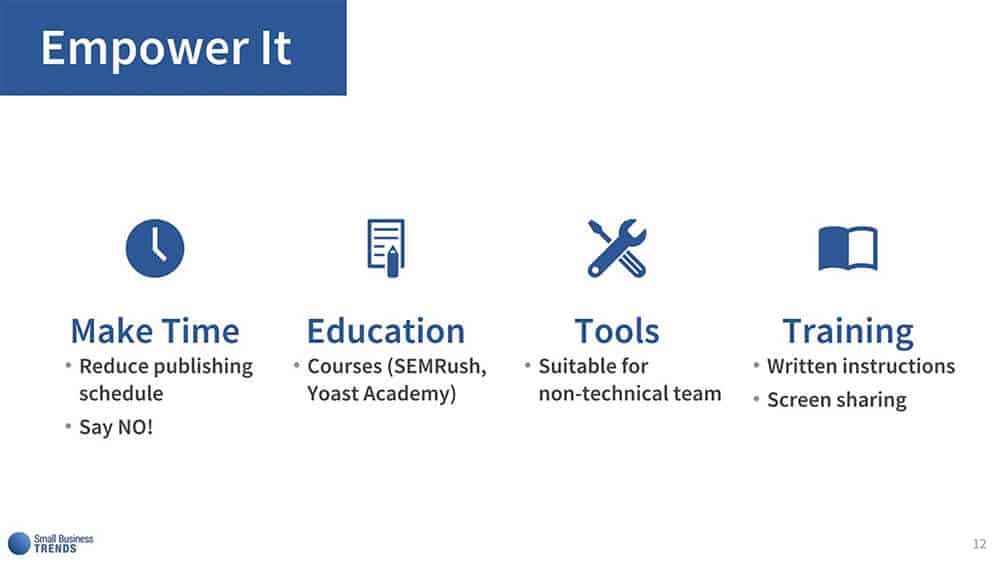

Small Business Trends used a myriad of tools and plugins to assist with their technical fixes, though they admitted that what worked for them will vary for every publisher. In addition to compiling the following suggestions, the team at Small Business Trends put together an article about some of their tips and best practices at SBT.me/improve.
Here’s a list of some of the specific tools they used…
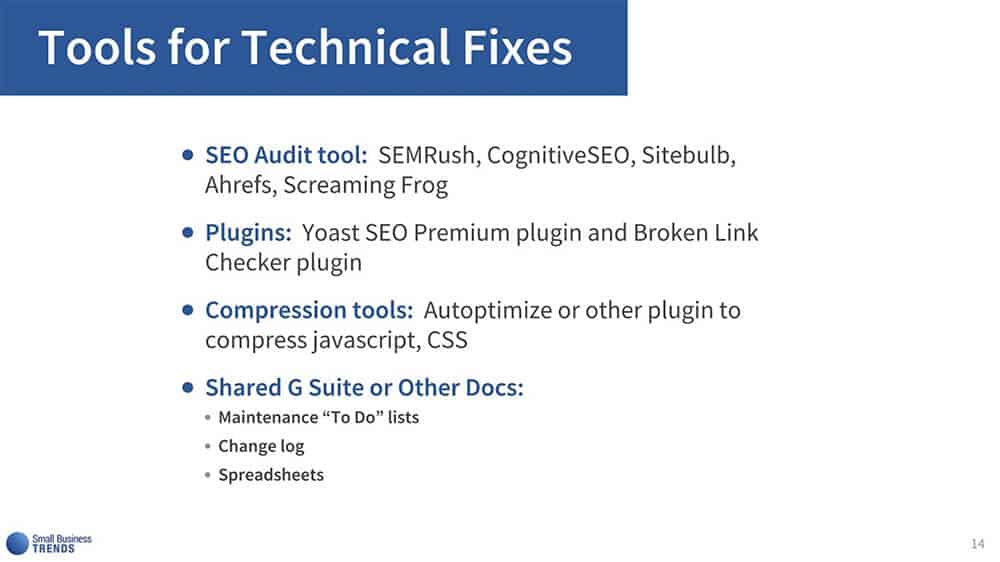
Now, back to not pruning content
The number one rule of improving the quality of content for Small Business Trends was don’t eliminate anything you’ve already published.
Anita felt strongly that it’s important to start looking at older content as an asset and consider how to get more out of that asset. Publishers can get more out of their content by updating it rather than deleting it, thus preserving the site’s authority while making the site altogether better.
Deleting content has lots of unintended consequences. It affects internal linking, page authority, backlinks, and your sitemap architecture. It is extremely difficult to do without causing major harm even when you might not be able to clearly see why “this one crappy page” would matter.
For example, a friend of Anita’s had a successful, 10-year-old website. One day, he took the advice of an expert and deleted everything on his site that was over two years old without redirecting any of the URLs.
About 6 months later, the website owner received an offer from an interested buyer, but the offer price was very low. After reviewing the site, Anita saw he had actually gutted the entire site and deleted all of his links and authority. Unfortunately, the price tag was fitting.
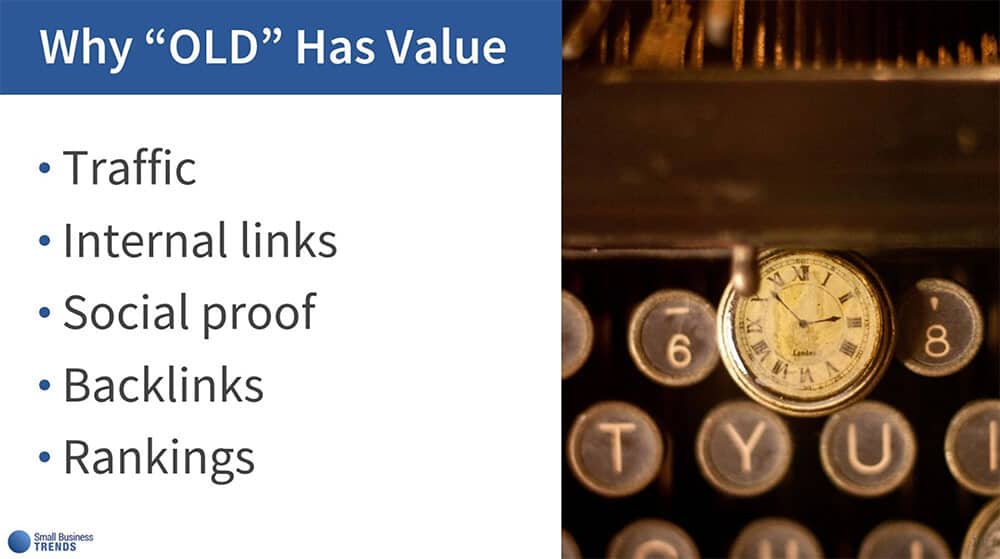
Why “old” has value:
- Traffic: older sites tend to have bits of traffic to a vast assortment of pages, rather than maybe just one popular article.
- Internal links: one of your older pages may be linking to a better page. If you take away the older page, you also take away the weight to the better page.
- Social proof: older content has likely been shared on various social media platforms. Additionally, some articles have a long string of comments and the best engagement metrics on the site.
- Backlinks: if any of your content has backlinks, it’s likely your older content.
- Rankings: you might be surprised what a really old page is ranking for. Even if the page is ranking for only one keyword that isn’t highly searched, it still has value and can be improved.
How do you update outdated content?
According to Anita, the first step is to gather all of the data you can about your website and its individual pages. Then, go through each page and ask yourself the following questions:
- Did it have any traffic in the last 90 days, 6 months, etc.?
- Does it have any backlinks to it?
- Does it rank for anything?
- How many comments and shares does it have?
What you do with your pages will need to be determined on a page-by-page basis. The page will fall into one of these three categories (though the majority of your pages should fall in the first section):

For example, Anita wrote an article in 2004 on an evergreen topic, but the article had become buried deep under newer content within categories containing 2,500 posts. This particular page may have just fallen out of the index because it was buried in an area where pages before it was broken and thus wasn’t being crawled. A good place to start would be to update the content so that it can be published as a new piece.
If a page can’t be improved, the content should be consolidated or rewritten, and then a 301 redirect code should be implemented to the new URL. Plugins like Yoast can be especially helpful in this step.
As a last resort, content can be removed, but this should only be done if you clearly understand the risks in a technical way.
While some experts say to never remove any content from your site, Small Business Trends did remove some content very sparingly. For instance, a flagged, three-sentence article about a past webinar from 12 years ago with broken links and images was something that they felt comfortable deleting.
Anita shared that under no circumstances should content be deleted in anything other than a one-off basis.
Which articles should publishers improve first?

Begin with articles with organic rankings on page two or three, within position 11-30. These and ones that you personally deem important are the first ones you can work on improving. Again, consider a page’s traffic, internal links, social proof, backlinks, and ranking.
Their case study on content ROI
Let’s look at an eight-year-old article from Small Business Trends. On December 2018, the page received 79 visits. Small Business Trends enhanced the article in January 2019 and almost immediately, ranking improved and the page received a thousand more organic visits per month. That number is still increasing.
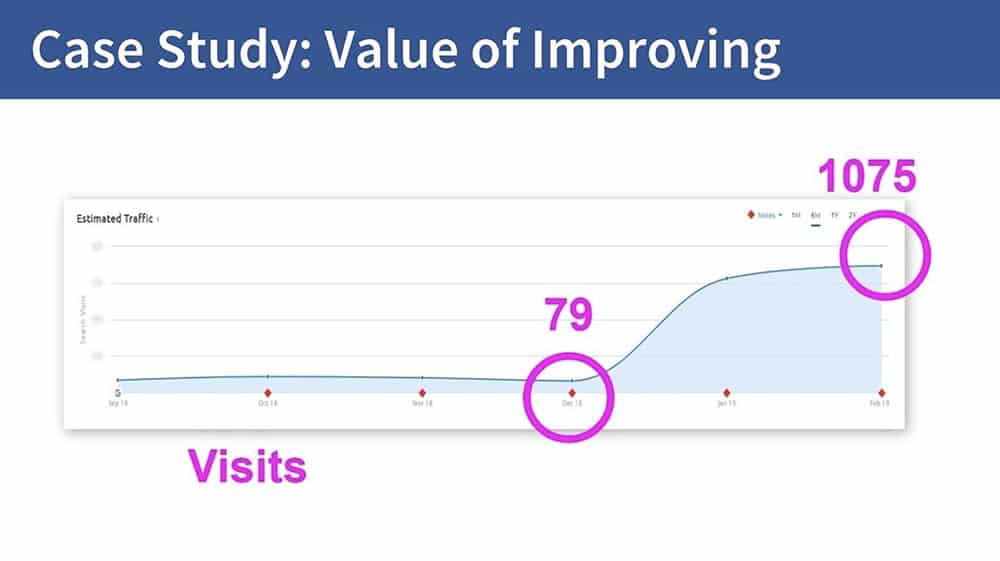

If you were to augment 100 pages of your site and receive a thousand more visits per page, that would equate to 100,000 more visits to your site. If your EPMV (earning per thousand visitors) is at $13, you can earn $1,300 more per month just from your existing content. That means that you have the potential to increase revenue from your existing content by $15,600 per year. – Anita Campbell
Obviously, this won’t be the result of every page you augment. Results of content revision can vary —Small Business Trends has had pages that have gotten far greater than 1,000 more visits and some have only received 10 more visits per month. You may have to revise 200 pages to achieve the revenue you want. But remember, this is revenue from content you already have.
The great thing about the improvements smallbiztrends.com implemented is that it was all just content work and social media shares —nothing they did required any special SEO or technical training.
Following tips previous blog posts on how to improve search ranking for old content and re-purposing old content by Tyler Bishop, Anita and her team conducted the following improvements:
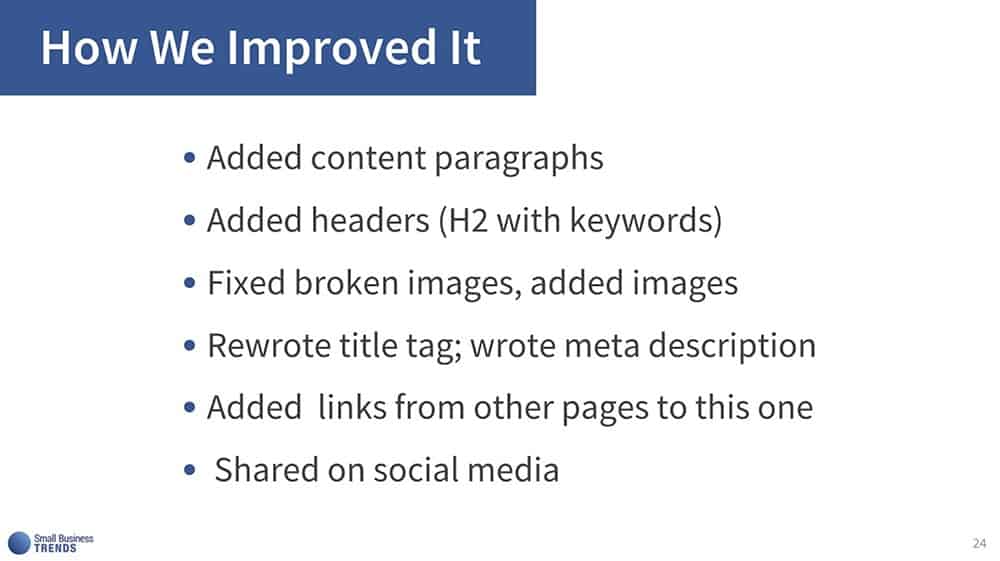
Create a plan for updating content that has value
Anita shared that this entire project was also a great time to step back and consider all of their content.
If you don’t already have one, consider creating a roadmap of your content, such as the one Anita and her team uses here:
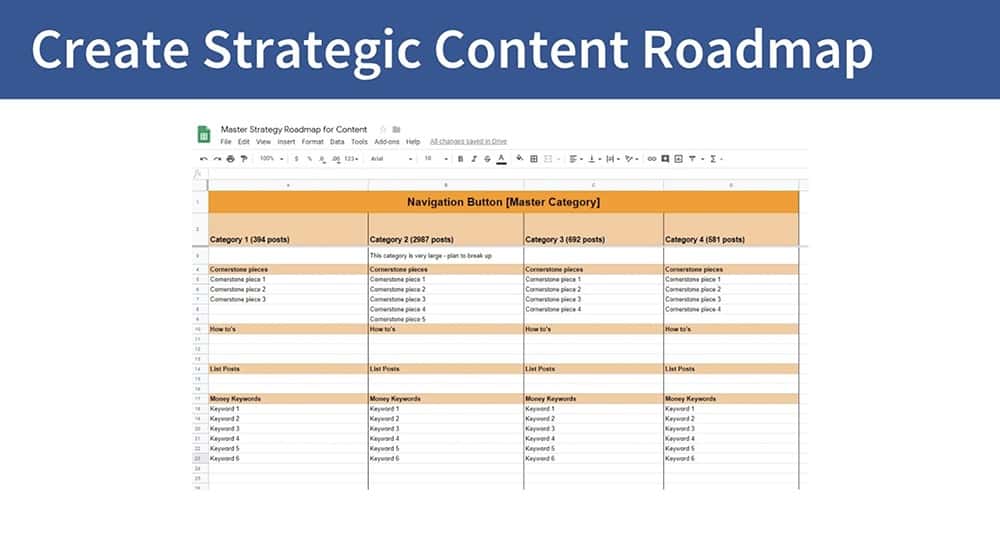
While organizing and planning your content, you should also ensure you know what categories are earning you the most money. Tools such as Ezoic’s Big Data Analytics provides reports for publishers to segment their content in various ways, including by topic.
Until analyzing this information, Small Business Trends had no idea that one particular topic was driving their overall revenue.
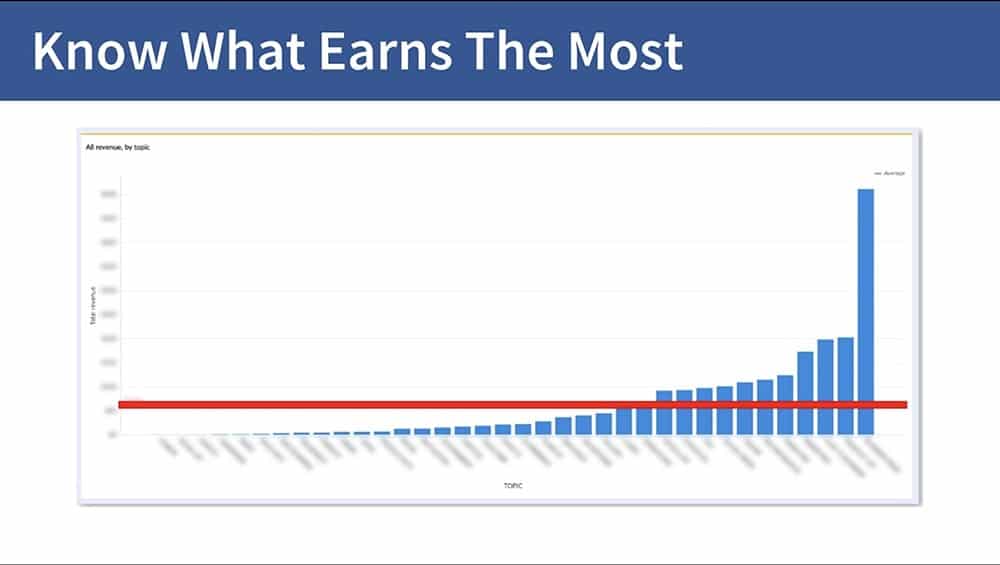
However, looking at a graph of EPMV by topic, there is a different pattern.
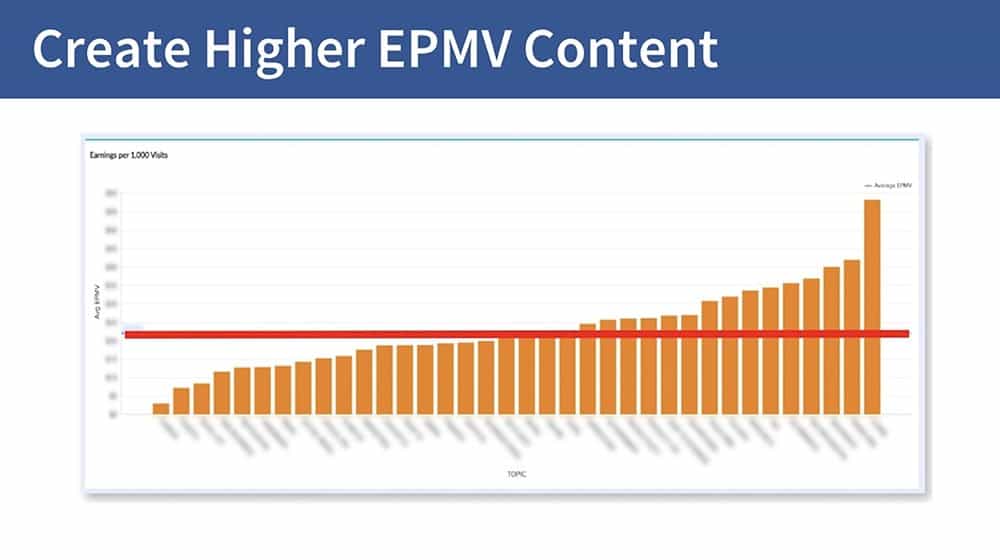
Instead of focusing on topics that just brought in straight revenue, Small Business Trends can lift revenue overall and overtime for the entire site by driving more traffic towards their landing page content that brings in the highest EPMV.
Something we discussed on Ezoic Explain here.
Dig into your content and see which types of articles produce the highest value sessions, not pageviews.
Reducing content expenses along the way
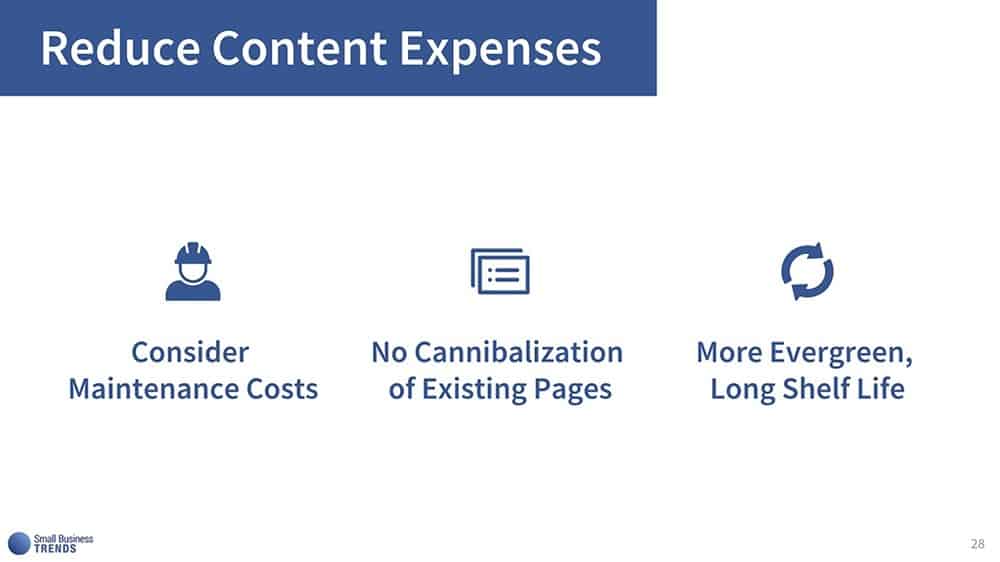
You can also bring in more revenue from your content by reducing overall content expenses:
- Consider maintenance costs: some of your pages may be more tedious and costly to maintain than others, such as pages with a lot of links. Is it worth keeping the page up-to-date if it is costing more time and resources than it is worth?
- No cannibalization of existing pages: no publisher ever plans to write the same content over and over again, but that becomes more difficult to avoid the older your site is. When publishing new content, make sure and go through your old content to see if there is an article you can update rather than completely publishing something new. The age of the page will give it higher authority, and the newness of the content will put it back on viewers’ radars.
- More evergreen, long shelf life content: try to not create content that will be irrelevant a year from now. Reliable articles that can stand the test of time and provide steady, consistent revenue are part of the foundation your site should be built on.
Moving on to website architecture as the last step
According to Anita, once your website’s technical issues are fixed and your content is augmented and optimized, you can move on to architecture.
Small Business Trends has started to focus on making their internal linking more structured. It tends to be that the same content that gets internally linked to time and time again, so the strong get stronger and the weak get weaker.
Having a structured methodology for internal linking will help you and your team to increase traffic to multiple pages on your site rather than just a few. This is something Google search looks at when determining which pages on your site are the most important and potentially helpful to searchers.
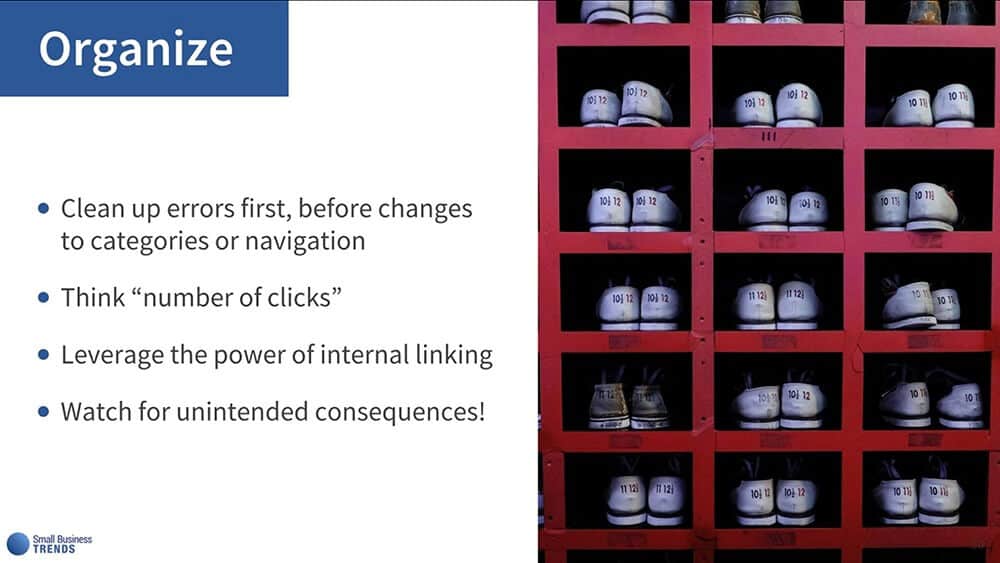
Don’t redesign your site, tweak it…
Think tweaks, not redesign. There are small improvements to your site that you can make that can drastically improve user experience, and thus revenue. Big redesigns are risky and may have unintended, negative consequences for your content. – Anita Campbell
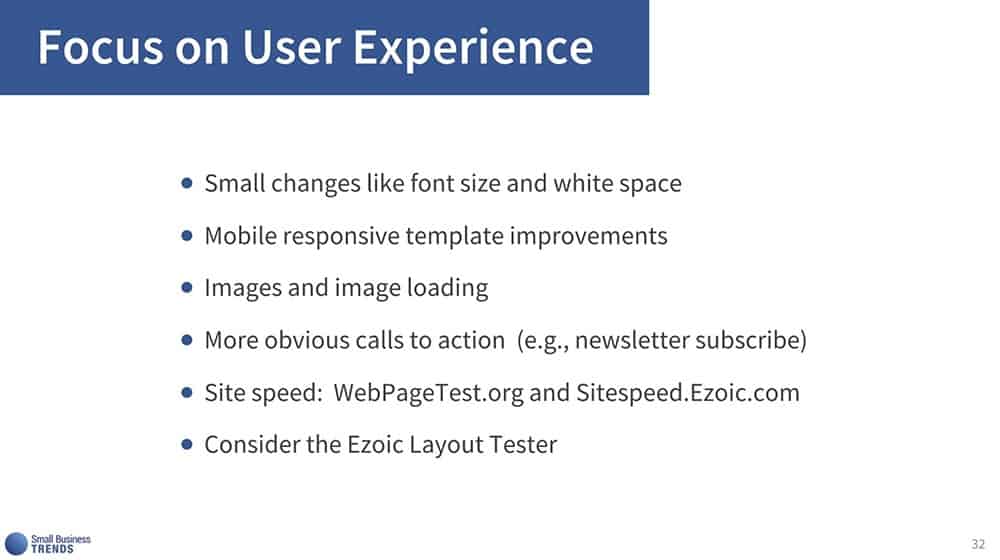
Results: Does All Of This Work Pay Off?
In short, yes.
Anita and her team successfully increased website traffic and grew ad earnings by over +600% in one year using the information shared above.
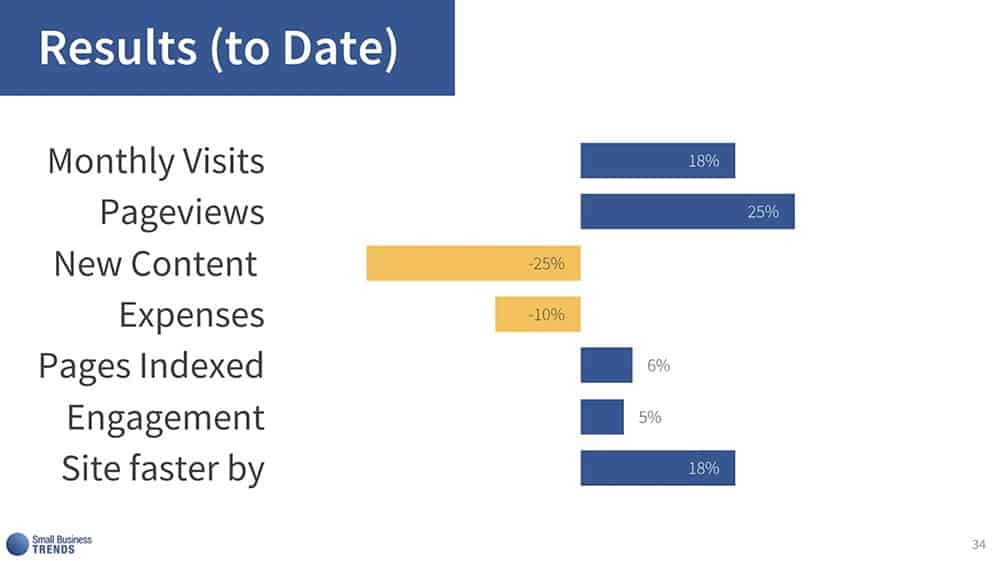
Since November 2018, Small Business Trends has decreased its new content output by 25% and expenses by 10%. However, visits, pageviews, pages indexed, engagement, and site speed all improved.
It’s worth noting that the number of pageviews has increased just as much as the amount of new content has decreased, showing that you can continue growing your site without creating anything new.
Summarizing the actionable steps from Anita’s presentation
In summary, Anita and her team at Small Business Trends followed these steps to make the content they already created work harder for them:
- Set up an SEO audit tool to crawl your website.
- Organize the tasks into manageable categories.
- Work your way through the technical errors found by the SEO audit: broken pages, bad WordPress plugins, broken CSS, and broken links. If the list is long, break up the errors into manageable projects to complete over time.
- After fixing the technical issues, move on to your content. Start by looking at your pages that rank on the second or third page organically, and consider the page’s traffic, internal links, social proof, backlinks, and rankings.
- You should work to improve most of your content. Pages can be improved by adding content paragraphs, headers, fix broken images, rewriting title tags, adding links from other pages, and sharing on social media. Consider making a strategic content roadmap to stay on course and keep track of internal links. If content can’t be improved, reorganize or consolidate it and then redirect the page.
- Once your content is well managed, you can move onto working on your site’s architecture, including optimizing categories or navigation and internal linking.
- The last thing to focus on is your site’s design. Any changes you make should be small tweaks and enhance user experience: font size, site speed, and images.
Questions? Comments? Concerns? Feel free to leave a comment and I’ll share any info I can.

Tyler is an award-winning digital marketer, founder of Pubtelligence, CMO of Ezoic, SEO speaker, successful start-up founder, and well-known publishing industry personality.
Featured Content
Checkout this popular and trending content

Ranking In Universal Search Results: Video Is The Secret
See how Flickify can become the ultimate SEO hack for sites missing out on rankings because of a lack of video.
Announcement

Ezoic Edge: The Fastest Way To Load Pages. Period.
Ezoic announces an industry-first edge content delivery network for websites and creators; bringing the fastest pages on the web to Ezoic publishers.
Launch

Ezoic Unveils New Enterprise Program: Empowering Creators to Scale and Succeed
Ezoic recently announced a higher level designed for publishers that have reached that ultimate stage of growth. See what it means for Ezoic users.
Announcement
